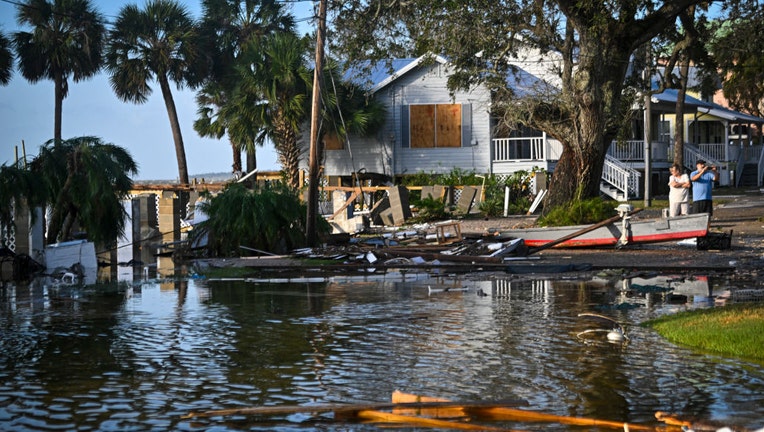What does flood insurance cover?

Residents inspect the area after Hurricane Helene made landfall in Cedar Key, Florida, on September 27, 2024. (Photo by MIGUEL J. RODRIGUEZ CARRILLO/AFP via Getty Images)
Most home insurance policies will not cover flood damage, which can cost homeowners a ton of money if their property is damaged by flood water.
Consumers without flood insurance have options available to purchase flood insurance coverage to protect their home from floods.
Here’s what you need to know about flood insurance coverage.
What is flood insurance?
Flood insurance helps cover physical damage to a resident’s home and personal items from floods or related losses from rising water. According to Allstate, consumers can buy a policy on-line from Beyond Floods through National General, an Allstate company, or they can purchase a policy online through the government-run National Flood Insurance Program (NFIP).
What does flood insurance cover?
If a flood happens, the National Flood Insurance Program (NFIP) policy covers direct physical losses to your structure and belongings, according to Floodsmart.gov, an official website of the U.S. Department of Homeland Security.
RELATED: Deadly Helene downgraded to tropical storm after making landfall in Florida: What to expect Friday
The NFIP offers two types of coverage – building coverage and contents coverage – to protect your home and belongings. Here are examples of what is covered with NFIP flood insurance:
- Electrical and plumbing systems
- Furnaces and water heaters
- Refrigerators, cooking stoves, and built-in appliances like dishwashers
- Permanently installed carpeting
- Permanently installed cabinets, paneling, and bookcases
- Window blinds
- Foundation walls, anchorage systems, and staircases.
- Detached garages
- Fuel tanks, well water tanks and pumps, and solar energy equipment
What isn't covered by flood insurance?
Flood insurance covers losses directly caused by flooding. According to Floodsmart.gov, a flood is an excess of water on land that is normally dry, affecting two or more acres of land or two or more properties.
RELATED: FOX donates to Red Cross Hurricane Helene relief efforts: Here's how you can help
For example, damage caused by a sewer backup is covered if the backup is a direct result of flooding. If the sewer backup is not caused directly by flooding, the damage is not covered.
These are examples of items not covered by building or contents coverage:
- Temporary housing and additional living expenses incurred while the building is being repaired or is unable to be occupied.
- Property outside an insured building. For example, landscaping, wells, septic systems, decks and patios, fences, seawalls, hot tubs, and swimming pools.
- Financial losses caused by business interruption.
- Currency, precious metals, stock certificates and other valuable papers.
- Cars and most self-propelled vehicles, including their parts.
- Personal property stored in basements.
Is a storm surge covered by flood insurance?
An NFIP policy covers damage caused by water entering your home from the ground up due to a storm surge, heavy rainfall or the overflow of a body of water, such as a lake or river. A storm surge is when a massive amount of water builds up and comes ashore during a hurricane, per FEMA.gov.
How much is flood insurance?
Homeowners in the U.S. pay an average of $800 annually for a flood insurance policy from the National Flood Insurance Program (NFIP), but prices will likely change if you choose to go through a private provider, according to Bankrate.com.
Flood insurance costs vary depending on where you live. Bankrate has a breakdown of how much flood insurance costs on a state-by-state basis, with rates gathered from FEMA.
How do I file a flood insurance claim?
Flood insurance claims can be filed through these steps:
Notify your insurer to start the claims process-After experiencing a flood, contact your agent or insurance company to file a claim. Make sure you have the following information handy:
- The name of your insurance company
- Your policy number
- A telephone and/or email address where you can be reached at all times
An adjuster should contact you within a few days of filing your claim. If you do not hear from an adjuster, you can contact your insurance agent or company again.
Document the damage- It is important for people filing a claim to separate damaged from undamaged property in their homes. According to FEMA, your adjuster will need evidence of the damage to your home and possessions to prepare your repair estimate.
- Take pictures of all the damaged property, including discarded objects, structural damage, and standing floodwater levels.
- Make a list of damaged or lost items and include their date of purchase, value, and receipts, if possible.
- Officials may require disposal of damaged items so, if possible, place flooded items outside the home.
Complete a proof of loss to support your claim
According to FEMA, your adjuster will assist you in preparing a Proof of Loss (which is your sworn statement of the amount you are claiming including necessary supporting documentation) for your official claim for damages.

